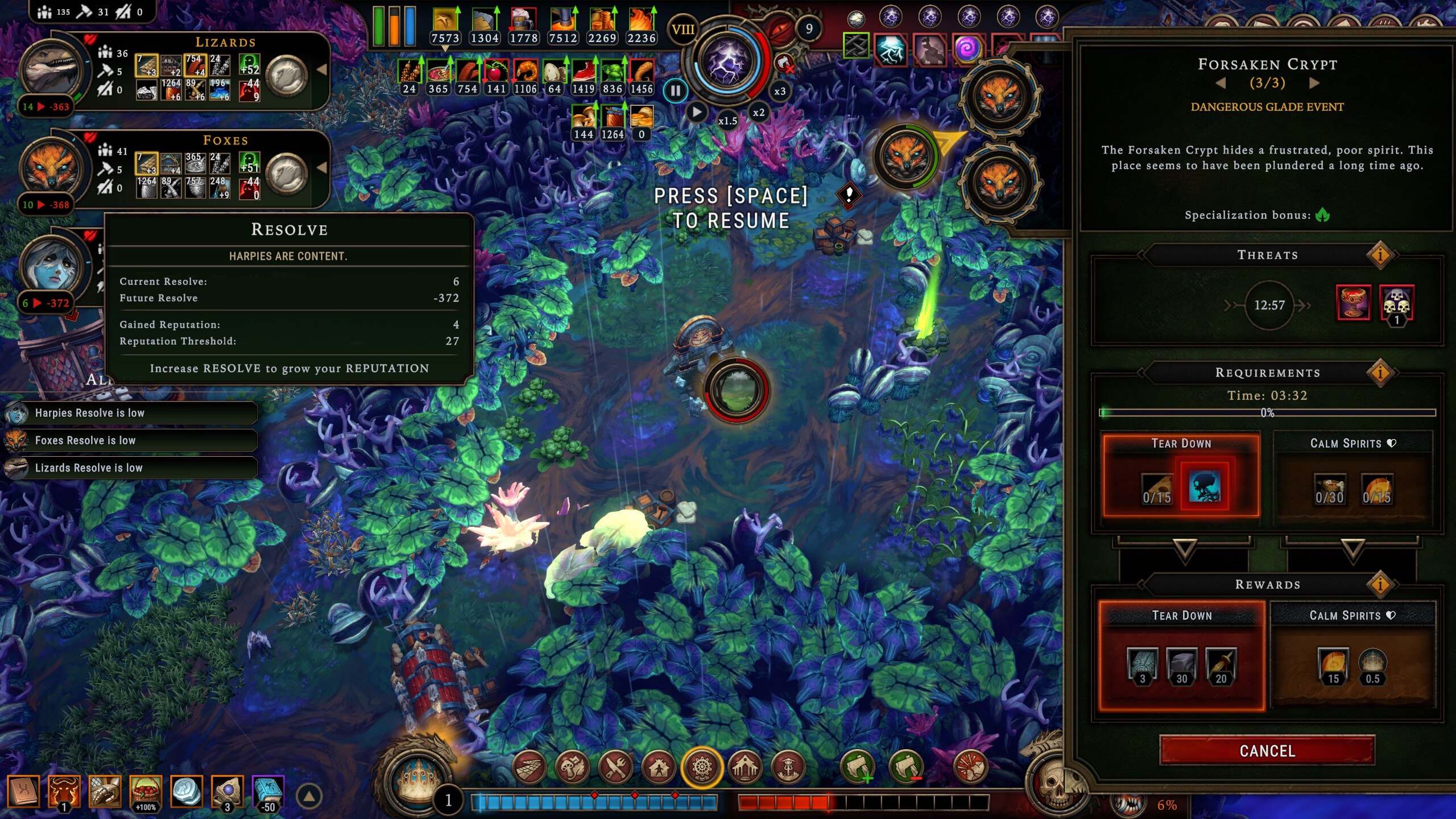The pluses are:
- nice art style, music, general feeling, setting has some promise;
- rather tight balance;
- adjustable production chains with variable I/O that should potentially offer a possibility of creating mechanically different settlements that integrate into local map conditions.
The minuses are... well, the game design in general.
First, the devs went for a 3d-engine, probably because of some dumb "we're in 21 century" technological reasoning.
They had enforced this decision with a geographical setting of "eternal forest". Probably because modeling complex terrain in 3d engine is harder. However the maps become functionally similar: you have forest you cut through to reach glades ("goody huts"). That's it. No rivers, mountains, creeks, etc. It's the same forest wall everywhere, and every mission you steamroll all over it. Even if the map implies a different biome (like, "we're in the jungle") the change is purely numerical ("when you cut wood you also get some insects").
Compare it, e.g., to the maps in Caesar or Stronghold. Every mission is visually and mechanically different there.
And the maps themselves are significantly larger, since 2d engines allow you to make hundreds of squares-wide maps.
Secondly, there's a limited amount of functionally different resources.
The game has several gatherer camps that feed off limited resource points. Gathering stone and gathering meat are functionally the same: you build a camp for 2-3 meeples, the meeples come to a resource node randomly placed on the map, hack at it and return with the loot to a warehouse. When the node depletes, you either move the camp or destroy it.
It has tree walls that you can cut through via lumberjack camps (that are otherwise completely equal to other gatherer camps).
It also has farming. You build a farm near "farming plot" resource nodes randomly placed on the map, seed the plots, time passes, meeples harvest stuff.
It also has mining. You build a mine on top of "mineral" resource nodes randomly placed on the map, meeples get in the building, comes out with an ore. When the node depletes, you destroy the mine.
(it also has ranching, though I haven't played long enough to unlock it)
Compare it to raw materials in Stronghold or Caesar series.
In Stronghold you have deers that run around the map and hunters physically go to shoot them. Hunters can be killed by wolves or enemies (or shoot enemies). You can hunt out the game completely and then starve out if you have no other source of food.
You also have grain farms and apple orchards that can be placed only in lowlands, near the rivers; you see where the lowlands are, sometimes they're in places that are hard to defend.
If you don't want to be defenseless, you have an option of cow farms, that are large and unproductive but can be placed on the highlands.
There're stone nodes for quarries and iron and those are unlimited (because medieval folk can't realistically mine all the stone out of earth, FFS). Iron and oil nodes are usually in swamps or other hard to reach and/or hard to defend regions.
Oh, and trees sometimes throw off new saplings that (very) slowly grow, so if you're careless you can deplete all the wood on the map (you also can preserve some for reforestation; and it's not even a viable mechanic, just a curious feature).
e.g. Compare the maps here.
They're visually very different.
The same goes for Caesar (though I remember it more vaguely). Clay is usually on the river shore, the fishing ports obviously require rivers, and farming plots comprise of small (or not) valleys of fertile soil. Oh, and trading ships physically move over the map.
Again, maps are visually pretty different.
While we're at it, traders in AtS seem to arrive at your trading post via orbital insertion. Maps have no road connections to your capitol (even though lore implies that it's really important). Your starting plot is completely surrounded by forest from all sides, always, since you've probably came via this.
Thirdly, production chains and engine building.
The game loop consists of you trying to create a production chain in a limited time.
The difficulty of the game comes from
1. you discovering what resource nodes are present on the map by cutting trees, simultaneously increasing the difficutly (more cutting - more maluses),
2. choosing 1 out of 3 building blueprints after completing resource gathering quests,
3. completing enough of those quests to get buddy points from your employer,
4. doing it all on 3 global timers of: "forest gets angrier", "your employer gets angrier" and "meeples are opex resource sink".
At its heart the game process isn't inherently different from the one in Stronghold or Caesar (gathering army to kill invaders or hamstering resources for caesar are both economic tasks).
But functionally, the fact that you're always, always are optimising vs two obvious timers and a few hidden ones makes all the missions look similar. Devs have locked themselves in the same loop of gradually and almost linearly increasing difficulty in each mission.
They don't have an option of, say, beginning the mission with a crisis the player almost loses to, then gradually rebuilds, then crisis repeats at the end of the mission.
The devs are also punishing the player for success. Without an external threat, the difficulty comes from your pops getting whinier as a reward for your expansion, because of "forest and weather". Even if you burn up all the trees in visible range around the downtown and nobody has died yet, your hipster meeples would still bleat that it's time to get scared, give them some booze or they'll run away.
It's a lazy game design.
And thank god that the game has no global warming.

































